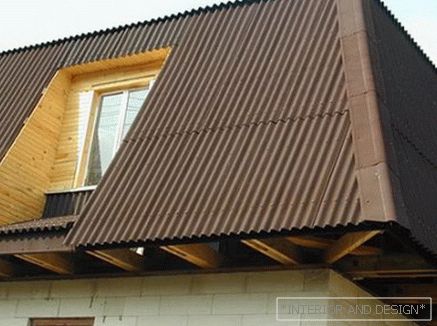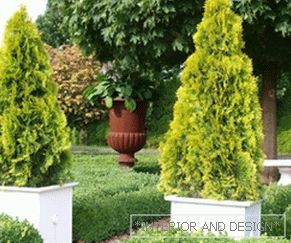 Often, when creating landscape compositions from living plants, there is a need for unpretentious plants that have sufficient aesthetic value. This may be due to the conditions on the site itself (harsh climate, poor soil, etc.), lack of knowledge or time for proper care.
Often, when creating landscape compositions from living plants, there is a need for unpretentious plants that have sufficient aesthetic value. This may be due to the conditions on the site itself (harsh climate, poor soil, etc.), lack of knowledge or time for proper care.
It is to such a group of unpretentious tree crops that the Thuja western Smaragd belongs.
Content
- 1 Description tui Smaragd
- 1.1 Features of the species
- 1.2 Positive and negative features of the species
- 2 Agrotechnics
- 2.1 Landing
- 2.2 Care
- 2.3 Reproduction
- 3 Pests and control methods
- 4 Application in landscape design
- 5 Conclusion
Description tui Smaragd
Features of the form
Western thuja Smaragd is a tree with high decorative qualities. Krona forms a narrow enough dense, pyramidal shape. A characteristic feature of this form is the color of the needles, which does not change in the winter, which is not inherent in all forms of this plant. The tree grows to a height of 5 meters, and the diameter of the crown can reach 2 meters. It can grow on almost any soil, but more like a soil containing lime or loam. The plant tolerates winter frost and shade tolerance. But prefers penumbra. The most common are two main forms - with yellow and green color.
Positive and negative features of the species
To the merits of thuja western include:
-
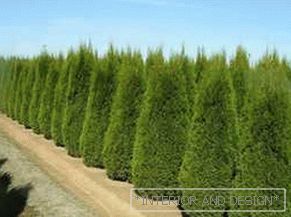 Long life, in favorable conditions, live to 150 years;
Long life, in favorable conditions, live to 150 years; - Easy to care and unpretentious;
- Low growth rate, which allows rarely to resort to pruning, without losing the decorativeness of plants;
- Good for forming crown;
- Does not inhibit the growth of other plants in the composition (both coniferous and deciduous);
- It has pronounced phytoncidal properties (the whole plant releases volatile substances that scare away a large number of insect species and inhibit the development of pathogens);
- It is equally well grown both as a part of landscape compositions, and as a hedge or container culture.
The disadvantages include:
- The presence of specific types of pests that, especially weakened plants, can in the short term cause significant harm;
- Does not tolerate stagnant water and wetlands;
- In winter, damage to plants due to snow is possible;
- In adverse conditions, forms with a decorative color needles (gold, red, etc.) acquire the usual green color.
Agrotechnics
Landing
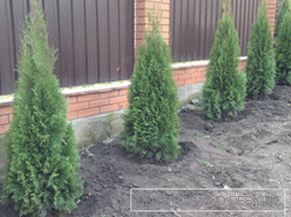 It is better to land a thuja in spring or summer. It is undesirable to plant in the autumn because the sapling may not have time to get stronger and not acclimatize.
It is better to land a thuja in spring or summer. It is undesirable to plant in the autumn because the sapling may not have time to get stronger and not acclimatize.
Although the thuja is western and unpretentious, it is still recommended to be planted in drained fertile soil. Can add to the soil humus or turf soil. Adding sand is good for providing air and water to the roots. Before planting a plant, it is required to pour wood ash, a little of any complex fertilizer, on the bottom of a prepared pit.
If the site is prone to waterlogging, the pit is dug 30-40 cm deeper than necessary, this place is filled with drainage (gravel, expanded clay, etc.).
Landing растения осуществляется так, чтобы корневая шейка находилась вровень с уровнем почвы. Потому что растение плохо переносит как заглубление, так и «высокую» посадку. Так как свежий, разрыхлённый грунт имеет свойство значительно оседать со временем, это нужно учесть при высадке. Дно ямы требуется утрамбовать, а после того, как растение высажено, нужно досыпать грунт, если он сильно просел у основания саженца.
If a sapling is purchased with a lump of earth, you should try not to destroy it when planting, since this additional injury for root system.
Planted Western thuja seedlings must be carefully watered to remove air voids near the roots.
Before the onset of the first wave of growth, which is a sign of plant rooting in a new place, young plants should be protected from adverse conditions - the summer heat and severe frosts in winter.
Care
Tui Smaragd is quite unpretentious, so further care is not time consuming and is available even to unskilled people.
To agrotechnical care measures include:
-
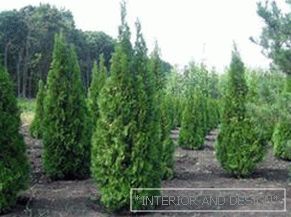 In hot years, moderate watering is desirable, but, the main thing is not to overdo it - the thuja tolerates a lack of moisture more easily than its excess;
In hot years, moderate watering is desirable, but, the main thing is not to overdo it - the thuja tolerates a lack of moisture more easily than its excess; - In the summer it is possible to use sprinkling. This increases the decorativeness of plantings and frees plants from dust settled on the needles;
- Loosening the soil in the stalk area. It is seen to a depth of no more than 10 cm, since the thuja is a plant with a superficial root system;
- In the fall, you can mulch the soil, a layer of 5-8 cm, sawdust or crushed bark. This is done to protect the roots from frost and moisture accumulation in the soil during the spring period;
- In the winter, pyramidal shapes are tied with twine. This is done in order to avoid damage to the branches under the weight of the snow.
Breeding
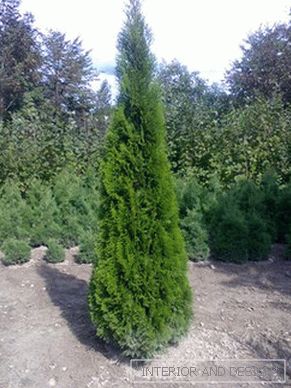 Thuja breeds well both with seed and vegetatively. But do not forget that seeds can not propagate the forms of thuja with exotic properties (such as: unusual color of needles, weeping form of the crown, etc.), since the seedlings are heterogeneous and rarely inherit the decorative properties of the mother tree.
Thuja breeds well both with seed and vegetatively. But do not forget that seeds can not propagate the forms of thuja with exotic properties (such as: unusual color of needles, weeping form of the crown, etc.), since the seedlings are heterogeneous and rarely inherit the decorative properties of the mother tree.
With the help of seeds, the natural forms of thuja are propagated either when breeding new varieties. It is also worth noting that the cultivation of seeds is a long process that requires attention. Since the seedlings are quite capricious and have a low growth rate.
The positive side of reproduction by seeds is that plants grown from seeds are best adapted to the conditions of a particular plot (soil composition, climate, lighting conditions).
Sowing is carried out to a depth of about 1-2 cm. The desired soil composition is one part of peat, one part of any light fertile soil, two parts of sand.
The seeds of most of the thujas do not need stratification (keeping the seeds at low temperatures). But after stratification, seed germination will be more friendly. Therefore it will be optimal to produce sowing in the fall.
After the appearance of the first shoots, the care consists in loosening the soil, timely watering, thinning of crops (it is necessary to leave the strongest and most developed), shading on sunny days, snow retention in winter, to avoid freezing of the crops. Do not forget that seedlings do not have a developed root system and do not tolerate any deterioration of external conditions. This leads to their mass death.
For a permanent place or in a container, the landing of the Smaragd Tui is carried out not earlier than 2-3 years of life, when they are strong enough.
Vegetative breeding method. For him cuttings are used. In this way, almost all types and forms of thuja are good.
The cuttings are harvested in spring, before the active growth phase. To do this, cut off mature branches about 12 cm long and about one centimeter thick. The cut is made at an angle of 45 degrees. Some experts recommend not cutting, but tearing off the cutting so that a small piece of bark and wood of the mother plant remains on it.
After that, the stalk is cleared of all the twigs, leaving them only at the top. After the cut, it is desirable to treat any rooting stimulator (they are now widely available) and land it in the ground. The soil is prepared from a mixture of sand, vermiculite and humus, in equal proportions. The presence of drainage holes in the container for planting, to remove excess water during irrigation. The soil around the cutting is slightly compacted and watered. Planted preferably cover with a thin film, for the first time, in order to avoid drying out of plants.
Sign of rooting cutting is the beginning of the active education new shoots. But do not rush to plant the plants, because at the beginning new roots are still very fragile and there is a danger of damaging them.


